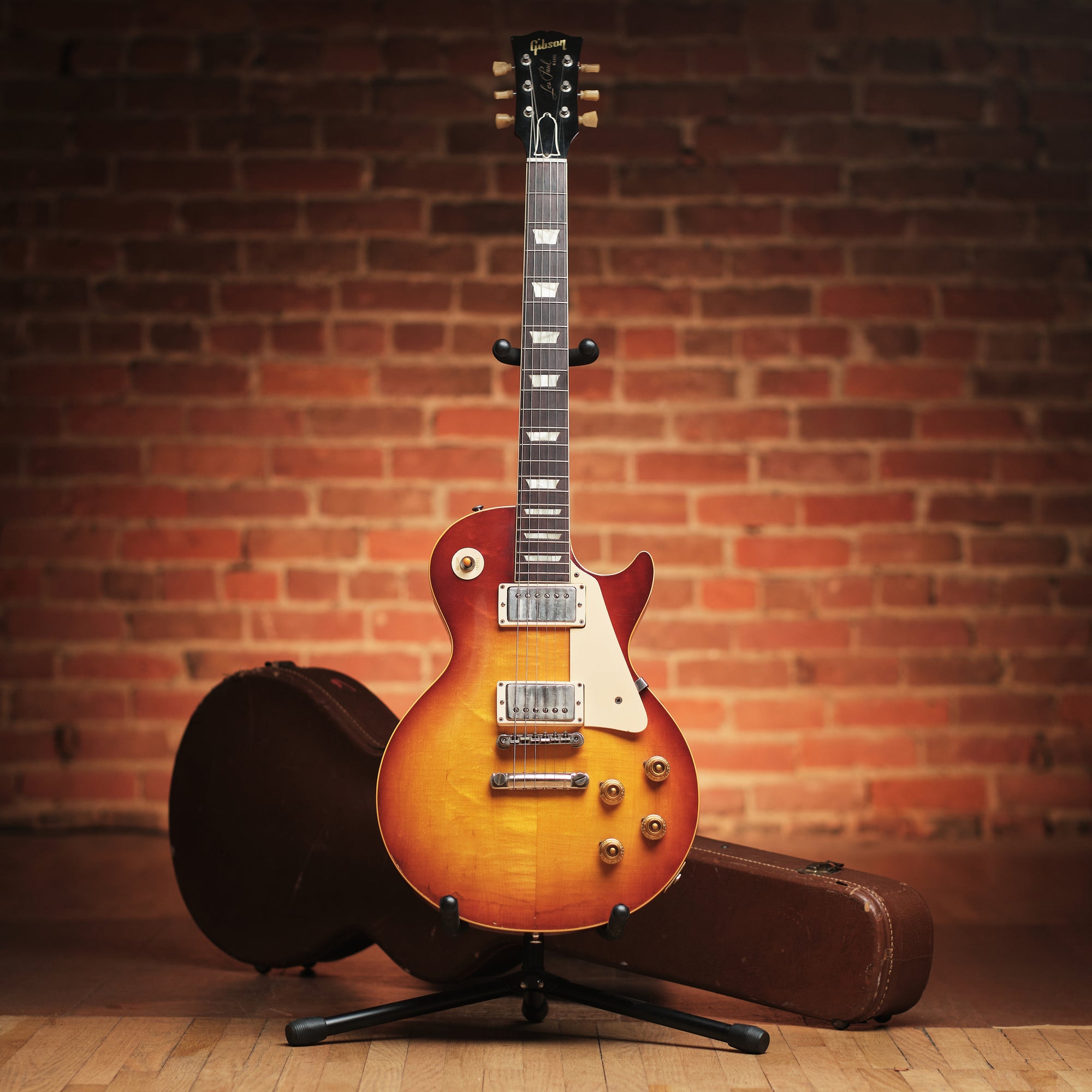1936 Martin 000-18 Shade Top

Don’t let the fact that we’re featuring two 30s shade top Martins this week desensitize you, these custom-order unicorns are as rare as it gets for the American flat-top acoustic guitar. Martin always prided themselves on using the highest quality woods and materials available, and made it a point not to spray their guitars with opaque colors or shading. This remained true until the early 1930s when Martin noticed another midwestern guitar company begin to have tremendous success with their line of sunburst-finished archtop and flat top instruments. Reluctantly in 1931, Martin made this “dark top“ finish standard on their new line of archtops, and available as a custom option for the remainder of their line. This new option (much like their archtops) were anything but a smashing success, and remaining examples of either are incredibly scarce today.
To find a 000 from ’36 in original condition is remarkable on its own, but the addition of the shade top puts this thing into the stratosphere. These just don’t come around, and when they do, they go immediately into permanent collections where they remain for decades. This example is currently sporting tuners off a ’42 000, but the original ’36 tuners are included in the original case, along with a leather strap original to the guitar and a slough of original case candy. The instrument has seen a few minor repairs over the years, all very routine and well-executed. The original bridge plate does have a small rosewood overlay attached over the pinhole area to protect the factory maple plate, but could easily be removed by a skilled luthier to return the internals to stock. Even among holy grail Martins, this guitar stands on its own. A 000-45 from the same era might give it a run for its money, but not without tacking another zero onto the price tag.
1944 Martin 000-21

While Martin’s “21”’ certainly isn’t their flagship series, it is their longest-running rosewood style of all time. Continuously available since the time of the American Civil War, it has been described in recent years as either a poor man’s 28 or as a rosewood 18. Some historians have advanced the theory that the model existed through the 30s and 40s in order to make use of Brazilian rosewood that didn’t quite meet Fred Martin’s fussy standards for use on higher-end rosewood models, although the wood of this particular example would look right at home on a 000-45.
Until last year, this 000-21 had been a single-family instrument living near Portland, OR. The original owner was a logger in the lower Cascades after the war, and by all accounts was a prolific after-hours entertainer for his friends and colleagues. After over a decade of heavy honest use, the guitar was passed down and promptly stored in the closet where it remained until summer of 2022. A neck set, refret, and some minor crack repair was all that was needed to get this exceptional Brazilian 000 up and running, and is now undoubtedly one of the finest sounding acoustic guitars in our inventory.
1944 Martin 000-18

The magic of a wartime Martin is a concept deeply entrenched in vintage guitar lore, and is completely affirmed when picking up this 000. The restrictions on use of certain materials (i.e. red spruce, metal) during that time certainly played a part in Martin’s golden era drawing to a close, but the transitional period during the war created an unintentionally unique chapter of their history. The ebony truss rod which had been retired along with bar frets in August of ’34 made a dramatic comeback, this time featuring the now-ubiquitous T-fret. The result? An incredibly light instrument that tips the scales at just a hair over 3 lbs and is more responsive that any guitar I can recall playing, even with the lightest touch imaginable. It just about jumps out of your hands with the mere insinuation of a right hand pluck. When folks talk about a “dry” sounding old guitar, this is the one they’re thinking of.
Apart from some mysterious and unfortunate finish damage below the bridge, the guitar remains in remarkably original condition for its age. The slightest hint of the inevitable B string crack is starting to develop along the edge of the pickguard, but remains entirely under control. It has had a recent and well-executed neck set along with a new saddle, par for the course on a guitar of this age. Depending on my current mood at any given moment, I could honestly say that any and all of the Martins featured this week are capable of being my favorite guitar in the shop. That said, I’d be lying if I claimed the 000’s haven’t enjoyed the lion’s share of attention. If you’re local, make some time to come down and play both of them before they’re gone. They are two of the truly outstanding vintage Martins I’ve come across, professionally as well as personally.
1932 Martin 0-18 Shade Top

I can’t imagine how you pack this much cool into a small-bodied guitar, but Martin certainly managed it with this exquisite 0-18 from 1932. Bar frets, light scalloped bracing, and a factory shade top check all the boxes for a golden-era flat top gem. Some crack repair and finish work on the back and sides might keep this example out of the Smithsonian, which is great news for all of us who pine after these pint-sized cannons. Built before the days when style 18s featured rosewood parts, it looks more like a mahogany style 28 than a modern 18. Beautiful jet-black ebony was used for the bridge and fretboard, lending a unique and glassy high end to an otherwise low/mid heavy tonal palette that will delight the fingerpicker and flatpicker alike.
I’ve already spoke about the incredible rarity of the factory Matin shade top, and our two examples from this week do well to illustrate how much variance was present throughout its brief tenure as a custom option. Because it was so infrequently ordered, Martin never really developed a standard method for spraying these dark tops. This particular example, like many from the early 30s, is a darker crimson shade, with an only slightly darker red around the edge. By the end of the decade, a pronounced 3-tone amber sunburst was the norm. In the interim, an oftentimes erratic evolution of technique produced a litany of sunburst variations, some more attractive than others but always interesting to observe. Even with a history of repair work, this is a once-in-a-lifetime instrument that would be the jewel of nearly any Martin collection out there.
1914 Martin 0-30

The progression of guitar design, like most vocations, has been largely evolutionary rather than revolutionary. However, the transition from gut to steel strings in Martin’s lineup through the late 1920s represents a landmark divide in the instrument as we know it. The steel string era is responsible for the two heavy hitters that dominate the market to this day: the OM and the Dreadnought, both introduced within a few years of steel becoming the norm. The common appointment styles like 18, 28, 42, and 45 are still the standard to this day. The gut string era, though, can seem quite foreign to the casual observer. The unfamiliar body sizes, styles, materials, and construction techniques are so distinct from the steel-string Martins we’re accustomed to, you could be forgiven for failing to identify one as a Martin at all.
The style 30 had a relatively short run from 1898-1921, but it spent its tenure near the top of the Martin line. Only 356 instruments were ever made in the 30 style, 162 of those being 0-30s. While our steel-string sensibilities may lead us to look down upon the smaller dimensions of the 0, the reality is that the model’s size perfect for the lower tension of gut strings. The now-iconic 000 was very nearly discontinued before the advent of steel strings because of its substandard tone. Early gut-string versions of the Dreadnought were so bad that Martin refused to build them under their own name for almost 20 years. As strange as it sounds, the 0 is arguably the largest effective gut-string guitar out there, and this is a tremendous example. The quality of the old-growth red spruce top (some folks call this Adirondack) is untouchable by anything available today, commercially or otherwise. The Spanish cedar neck is lighter and more reactive than a modern mahogany equivalent. The straight-grain Brazilian rosewood used for the back and sides absolutely puts to shame the all-too-common stump wood sets that flood the modern market. Don’t get spooked because this isn’t a 000, it is likely the best fingerstyle guitar you’ll find in our shop, or any shop for that matter.



